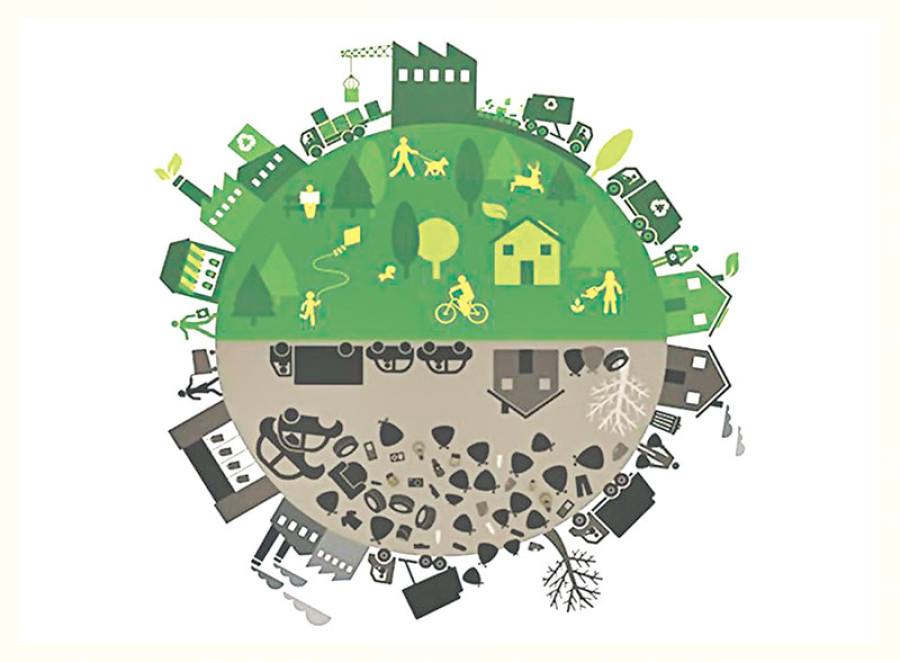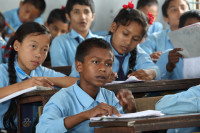Opinion
Reduce the carbon
Nepal’s share of greenhouse emission is negligible yet it ranks 4th in terms of vulnerability to climate change
Himalaya Bir Shrestha
In the recent years, countries in the Global North have started experiencing more extreme weather events. Heat waves in Europe, floods in Japan followed by forest fires in Sweden, Portugal, Greece and California are some of the latest examples. Developing countries in the Global South experienced such phenomena long ago. A 2015 report by the Asian Development Bank reveals the increase in the trend of climate related disasters. It states East and South Asian countries top the list of the regions affected. It would be wrong to attribute all extreme weather events to climate change. Growing evidence shows climate change could be contributing to their increasing frequency and severity. Scientists worldwide agree to the link between greenhouse gases (GHG) with global warming and extreme weather events.
Warming temperature
The atmospheric concentration of carbon dioxide, which is the main greenhouse gas, was stable for the past 400,0000 years. After industrial revolution, carbon dioxide concentration has risen dramatically from 280 ppm during mid-18th century to 408.47 ppm as of this year. According to a 2018 report by the National Aeronautics and Space Administration (NASA), 17 of the 18 warmest years in the last 136 years have occured after 2001 with 2014, 2015, 2016 and 2017. The year 2014 being the hottest one till date On a global scale, Nepal’s share of GHG is neglibile but it is located between two of the biggest GHG emitters—China and India.
Increased green house gas emissions in the atmosphere accelerate warming. On one hand, this could lead to increase in the water vapour content of the atmosphere leading to increased daily precipitation intensity and increased mean seasonal rainfall. On the other hand, it could also lead to increase in moisture evaporation from land and water bodies, increase in transpiration from plants affecting plant life and reducing rainfall.
Moreover, when rainfall strikes the drought stricken areas, the soils it hits is less able to absorb the water, increasing the likelihood of floods—a lose-lose situation. For many people in the Indian subcontinent, it is the variability of rainfall on shorter time scales that have the biggest impacts—intense heavy rainfall leads to floods and landslides, whereas break in the onset of monsoon for a week or more leads to water shortage and agricultural droughts. For example, in August 2017, for the first time in history, all the major rivers of Nepal flooded at the same time affecting 1.7 million people in 35 districts. Several districts experienced heaviest rainfall in over 60 years.
The 2015 Paris Climate Agreement aim of keeping the rise in the global temperatures well below 2 degrees Celsius and further limit the temperature increase to 1.5 degrees Celsius by the end of this century would require the global GHG emissions to peak as soon as possible and reach net zero by around 2050 (GenerationYes 2018). In the context of Nepal, this would imply reduction in the import of petroleum products, increased electricity generation by hydropower and other renewables, increased electricity access and electrification across different economic sectors, implementation of energy saving and energy efficiency technology and use of high quality fuels.
Way forward
For a country like Nepal which has a negligible share of GHG emission but ranks 4th in terms of relative vulnerability to climate change globally, climate change adaptation is equally important along with mitigation efforts. Different approaches like engineered ways of construction of flood levees and culverts, improved drainages and flood shelters, efficient irrigation, rainwater harvesting, early warning systems; ecosystem based approaches like floodplain and wetland restoration and conservation, green infrastructure, ecological corridors etc., are appropriate for adaptation. A paradigm shift from hazard based approach of adaptation to tackling the underlying causes of vulnerability and developing capacity through fulfilling financial, institutional and technological needs will increase effectiveness of adaptation plans.
Integrating climate foresights into development planning for climate resilient development and linking adaptation policies like NAPA (National Adaptation Programmes of Action) to national policies is essential to adapt to climate change and related disasters. A decade ago, ozone depletion used to be a hot topic for discussion which isn’t anymore. The Montreal Protocol of 1985 banned the production of Chlorofluorocarbons two years after the discovery of ozone hole. In January 2018, NASA’s Aura satellite had the first direct proof of the recovery of the ozone hole over the Antarctic pertaining to the decline in Chlorine in stratosphere (NASA 2018). This, in itself, is a testimony that our current joint climate action on a regional and global level to curb the GHG emissions could help safeguard the future of the planet, and the species living in it.
Shrestha is a DAAD scholar in Renewable Energy Management program at Cologne University of Applied
Sciences, Germany. Panthi is a researcher in disaster risk management




 8.12°C Kathmandu
8.12°C Kathmandu










